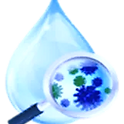
DISEASE DETECTIVES


Impact of Urbanization and Related Pollutants on Nutrient Cycles & Algal Blooms
The use of road salts in urban areas alters oxygen levels in water and leads to more phosphorus being released from lake sediments. Road salts can also cause soil nutrients like Mg2+, K+, and NH4+ to leach from the soil into aquatic ecosystems and can alter Ca2+, nitrogen, and carbon levels. Road salts can inhibit denitrification. The mobilization of soil cations into wetlands can increase primary production and anaerobic respiration. Anaerobic respiration in wetlands is the largest natural contributor of methane in the atmosphere, potentially exacerbating the greenhouse effect on earth's climate (Hintz & Relyea, 2019). Alternative road salt formulations such as using MgCl2 with beet juice and other distillation products are used to decrease the amount of chloride used. These additives also allow for the salt to stick to roads for longer periods of time, allowing less amounts of salt to be needed to replace the lost salts to continue clearing the roads of snow and ice. However, since beet juice and other distillation by-products contain phosphorus and carbohydrates, it acts as fertilizer that microbes feed on, which ultimately reduces the amount of dissolved oxygen (DO) in the water over time and changes the nutrients present in wetlands. Moreover, the amount of phytoplankton was highest in the treatments with additives due to their available phosphorus that they can feed on, offsetting the amount of microorganisms co-inhabiting the wetlands (Schuler & Relyea, 2017). These various additives can also increase the level of potassium (Oswald, C., 2020, personal communication). Increased salinity in combination with high nutrient levels in aquatic environments has been shown to lead to more frequent occurrence of algae blooms, especially cyanobacterial blooms, with increased release of cyanotoxins and considerable environmental and public health concerns. In addition, the increased sodium levels in freshwater reservoirs may pose a direct threat to human health (Pecher et al., 2019). Salts and heavy metals could act beyond the organismal level by disrupting ecosystem functions such as microbial processes and food-web dynamics, thus reducing ecosystem services such as carbon sequestration in wetlands, ponds, and lakes (Schuler & Relyea, 2018).
Flood Regulation
Team Ecogeeks are also looking into flood regulation, and how to use artificial wetlands, buffers, and rain gardens as solutions. Road salts clog stormwater catch basins, resulting in higher potential for flooding. It is also important to know that road salts impact the efficacy of buffers and rain gardens, as road salts decrease the ability of microbial communities to retain nutrients like nitrate and phosphate (Pecher et al., 2019).
Inuit Population & Climate Change
Team Ecogeeks are also looking at climate change which can connect to our teams’ case study on Inuit populations in Canada. We are assessing how climate change can worsen pre-existing poor drinking water conditions and lead to the development of waterborne disease such as gastrointestinal illness in populations (Harper et al., 2020). Climate change causes risk to drinking water due to water treatment infrastructure challenges related to extremely cold climates, rural and remote locations of many communities, and limited resources (Harper et al. 2020). In majority of communities within Arctic Canada, the most common waterborne illness is acute gastrointestinal illness. This arises due to the use of the wetland ecosystem for recreational and harvesting activities, with drinking water being identified as a greatest risk factor (Harper et al. 2020).
Effect of urban contaminants on terrestrial animals
Finally, our last integration is based on how urban contaminants can affect terrestrial animals. We found that animals like moose, deer, sheep, hares, and woodchucks are attracted to road salts, causing them to come onto roads and be the impact of frequent vehicle collisions. Birds also mistake road salts as seeds or food, but their kidneys cannot regulate sodium and chloride levels in the body like mammalian kidneys can. Salt toxicity in birds causes partial paralysis, tremors, and inability to fly, to name a few (Tiwari & Rachlin, 2018).
References
Arnott, S.E., Celis-Salgado, M.P., Valleau, R.E., DeSellas, A.M., Paterson, A.M., Yan, N.D., Smol, J., & Rusak, J.A. (2020). Road salts impacts freshwater zooplankton at concentrations below current water quality guidelines. Environmental Science and Technology, 54(15), 9398-9407. https://doi.org/10.1021/acs.est.0c02396
Hintz W.D., & Relyea, R.A. (2019). A review of the species, community, and ecosystem impacts of road salt salinization in fresh waters. Freshwater Biology, 64(6), 1081-1097. doi: 10.1111/fwb.13268
Pecher, W.T., Al Madadha, M.E., DasSarma, P., Ekulona, F., Schott, E.J., Crowe, K., & DasSarma, S. (2019). Effects of road salt on microbial communities: Halophiles as biomarkers of road salt pollution. PLOS ONE, 14(9). https://doi.org/10.1371/journal.pone.0221355
Schuler, M.S., & Relyea, R.A. (2018). A review of the combined threats of road salts and heavy metals to freshwater systems. BioScience, 68(5), 327-335. https://doi.org/10.1093/biosci/biy018
Schuler, M.S., & Relyea, R.A. (2017). Road salt and organic additives affect mosquito growth and survival: an emerging problem in wetlands. Oikos, 127(6), 866-874. doi: https://doi.org/10.1111/oik.04837
Tiwari, A., & Rachlin, J. W. (2018). A Review of Road Salt Ecological Impacts. Northeastern Naturalist, 25(1), 123-142. doi:10.1656/045.025.0110